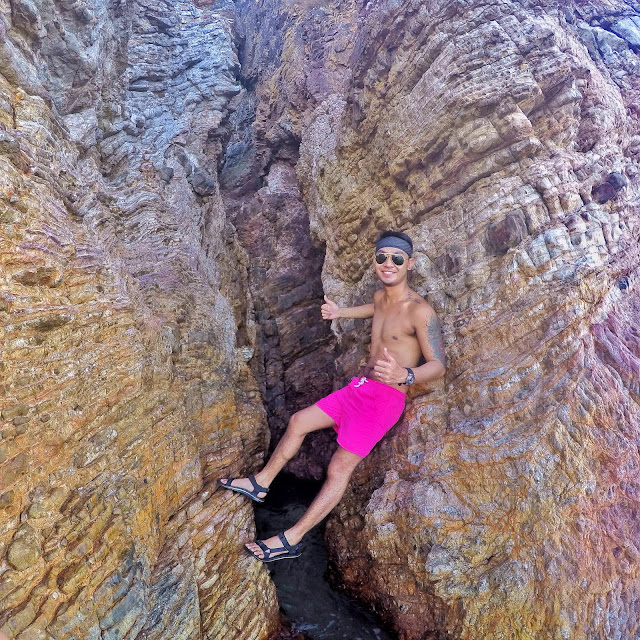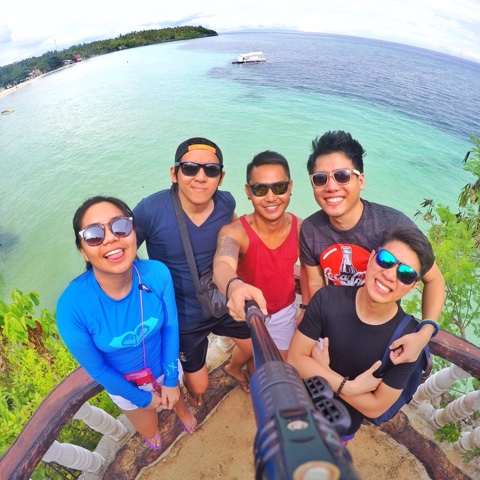Osmeña Peak is known to be the highest point in Cebu. Based on the web, it stands a little over 1000 meters above sea level. It is located in Mantalongon (Municipality of Dalaguete) and it is approximately 3 hours away from Cebu City. Barangay Mantalongon is also known as The Vegetable Basket of Cebu, so expect a lot of vegetable plantations along the way.

Osmeña Peak is one of the best options to start your climbing adventure. The climb is just easy and the cold weather makes it bearable. Going on a weekday hike is a good idea to avoid long queues and waiting for your photo op at the peak.

I first visited this place last year with my friends from Bacolod. We had our overnight stay in Oslob. From there, we hurriedly drove our way to Osmeña peak just to witness the beautiful sunset. We only stayed there for two hours as we were running out of time and we had to catch our scheduled trip back to Negros via Lite Ferry. I was in awe when I saw the beautiful sunset view from the peak and I told myself to visit this place again to witness the zero visibility.


Last October 5, my co-workers and I decided to go back to this place and spend a night on top of the mountain and also to spend my pre-birthday celebration. Hihihi. While on our way to Dalaguete, we were a bit worried because it was raining cats and dogs but good thing the weather cooperated when we arrived there. We started trekking around 7 in the evening and it was kinda scary because it was too dark. We only had one flashlight and our phones, of course as our only source of light. Our guide told us that we're the only group camping at the top of the hill which made it extra scary! Oh well, what's life without a little risk? It was almost 8pm when we reached the peak, so we started setting up our tent and getting ready for dinner.

We couldn't get a decent sleep due to strong winds that almost ruined our tent. I was too coward to step outside alone just to pee because I could not see anything. It was too dark and it scared the hell out of me. We stayed inside our tent the entire night, taking selfies, sharing our life lessons while listening to good music until we fell asleep. I woke up exactly at 5 am so I could feel the zero visibility experience. Hahahaha. At Last!





How to get there: (including expenses)
From Cebu South Terminal, ride a bus bound for Oslob or Bato. Travel time is 3 hours. And fare is 105 Php. Tell the bus driver to drop you off at Dalaguete junction.
Upon arrival in Dalaguete, you can hire a motorcycle (habal-habal) going to the jump off point for 100 PHp per person. Travel time is 30-45 minutes.
In case you need to buy water and food before going to Osmeña Peak, there's also a convenience store at the drop off point.
At the foot of the mountain, you have to register your name and the fee is 30 PHp.
To those who are planning to stay overnight, there's a fee of 50 PHp per tent.
You can also hire a guide to lead you to the peak and the fee is 50-100 PHp. Trekking is about 15-30 minutes.

Travel Tips
When trekking, bring lots of water. Cellphone signal is weak but there are areas where I was able to get 3G (globe), just enough for me to upload real time photos of my adventure. If you want to spend the night there, just bring your own camping gears. And always check the weather condition prior to visiting the place because climbing the mountain is too risky when it's raining. Safety first, always!


And always remember the LNT Principles by Center for Outdoor Ethics.
The Leave No Trace Seven Principles
Plan Ahead and Prepare
* Know the regulations and special concerns for the area you'll visit.
* Prepare for extreme weather, hazards, and emergencies.
* Schedule your trip to avoid times of high use.
* Visit in small groups when possible. Consider splitting larger groups into smaller groups.
* Repackage food to minimize waste.
* Use a map and compass to eliminate the use of marking paint, rock cairns or flagging.
Travel and Camp on Durable Surfaces
* Durable surfaces include established trails and campsites, rock, gravel, dry grasses or snow.
* Protect riparian areas by camping at least 200 feet from lakes and streams.
* Good campsites are found, not made. Altering a site is not necessary.
* In popular areas:
* Concentrate use on existing trails and campsites.
* Walk single file in the middle of the trail, even when wet or muddy.
* Keep campsites small. Focus activity in areas where vegetation is absent.
* In pristine areas:
* Disperse use to prevent the creation of campsites and trails.
* Avoid places where impacts are just beginning.
Dispose of Waste Properly
* Pack it in, pack it out. Inspect your campsite and rest areas for trash or spilled foods. Pack out all trash, leftover food and litter.
* Deposit solid human waste in catholes dug 6 to 8 inches deep, at least 200 feet from water, camp and trails. Cover and disguise the cathole when finished.
* Pack out toilet paper and hygiene products.
* To wash yourself or your dishes, carry water 200 feet away from streams or lakes and use small amounts of biodegradable soap. Scatter strained dishwater.
Leave What You Find
* Preserve the past: examine, but do not touch cultural or historic structures and artifacts.
* Leave rocks, plants and other natural objects as you find them.
* Avoid introducing or transporting non-native species.
* Do not build structures, furniture, or dig trenches.
Minimize Campfire Impacts
* Campfires can cause lasting impacts to the backcountry. Use a lightweight stove for cooking and enjoy a candle lantern for light.
* Where fires are permitted, use established fire rings, fire pans, or mound fires.
* Keep fires small. Only use sticks from the ground that can be broken by hand.
* Burn all wood and coals to ash, put out campfires completely, then scatter cool ashes.
Respect Wildlife
* Observe wildlife from a distance. Do not follow or approach them.
* Never feed animals. Feeding wildlife damages their health, alters natural behaviors, and exposes them to predators and other dangers.
* Protect wildlife and your food by storing rations and trash securely.
* Control pets at all times, or leave them at home.
* Avoid wildlife during sensitive times: mating, nesting, raising young, or winter.
Be Considerate of Other Visitors
* Respect other visitors and protect the quality of their experience.
* Be courteous. Yield to other users on the trail.
* Step to the downhill side of the trail when encountering pack stock.
* Take breaks and camp away from trails and other visitors.
* Let nature's sounds prevail. Avoid loud voices and noises.
More photos below:






Thank you for visiting my page. You may also follow me on Instagram- www.instagram.com/meljun1689 to know more about my travelogue. Or visit my Facebook https://web.facebook.com/meljun1689
See you on the road!














































































